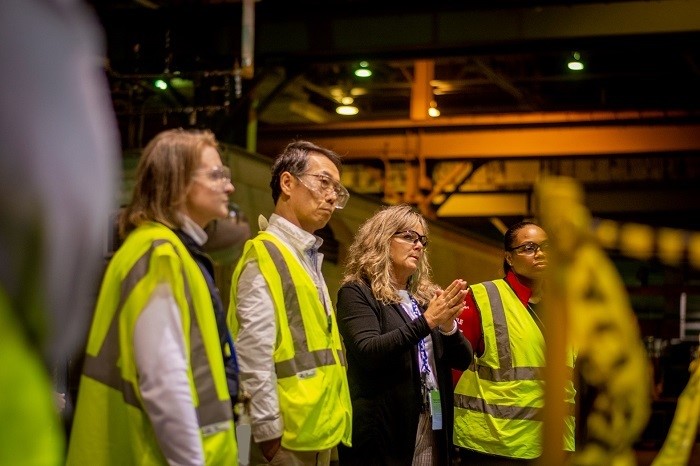A view of Los Alamos National Laboratory. (Photo: LANL)
The National Nuclear Security Administration announced that, in compliance with the National Environmental Policy Act (NEPA), it intends to prepare a site-wide environmental impact statement (SWEIS) to analyze the potential environmental impacts for continuing operations of the Los Alamos National Laboratory for the next 15 years. The SWEIS will also analyze the environmental impacts of legacy waste remediation being done by the Department of Energy’s Office of Environmental Management at the site.
Crews begin clearing the site on which Savannah River Site’s SDU 10 will sit. (Photo: DOE)
The Department of Energy’s Office of Environmental Management (EM) announced that it is preparing for construction of the final three planned saltstone disposal units (SDUs) at the Savannah River Site in South Carolina, which will complete the site’s liquid waste mission.
The SRS liquid waste contractor, Savannah River Mission Completion (SRMC), is overseeing the construction of the SDUs, which will receive decontaminated salt solution treated at Savannah River’s Salt Waste Processing Facility (SWPF).
Hanford workers will soon begin retrieving about 373,000 gallons of waste from Tank AX-101, shown here in an image from an inspection video shot. (Photo: DOE)
Washington River Protection Solutions (WRPS) is preparing to retrieve waste from Tank AX-101 at the Department of Energy’s Hanford Site near Richland, Wash. WRPS is the tank operations contractor at Hanford.
A DUF6 storage cylinder is moved at the Portsmouth DUF6 conversion facility. (Photo: DOE)
The Government Accountability Office is recommending that Congress clarify the Department of Energy’s legal authority to sell depleted uranium hexafluoride (DUF6) left over from uranium enrichment operations at the department’s Portsmouth Site in Ohio and the Paducah Site in Kentucky.
Rep. Jamaal Bowman during a hearing of the House Science, Space, and Technology Subcommittee on Energy.
The House Science, Space, and Technology Subcommittee on Energy held a hearing last week to evaluate the Department of Energy’s approach to research and development on new strategies and technologies to support the nuclear waste cleanup mission of its Office of Environmental Management (EM).
Workers inspect the IWTU’s process gas filter before the current confirmatory run. (Photo: DOE)
The Department of Energy’s Office of Environmental Management (EM) said it continues to make progress toward the start of operations of the Idaho National Laboratory Site’s Integrated Waste Treatment Unit (IWTU), having completed a final test run of the facility.
Operation of the IWTU, which was constructed to treat approximately 900,000 gallons of radioactive liquid waste, has been delayed a number of times, most recently due to supply chain issues.
The Waste Isolation Pilot Plant in southeastern New Mexico.
Reston, Va.-based Tularosa Basin Range Services (TBRS), a single-purpose entity under the umbrella of Bechtel National, has been awarded the 10-year, $3 billion management and operating contract for the Waste Isolation Pilot Plant (WIPP) by the Department of Energy’s Office of Environmental Management (EM). Located near Carlsbad, N.M., WIPP is the DOE’s geologic repository for defense-generated transuranic waste.
The new contract replaces the current WIPP M&O contract held by Nuclear Waste Partnership, which expires on September 30. The contract with TBRS was announced on July 11.
The first steel columns, each weighing up to 28 tons, were placed for a cocoon over the former K East Reactor building at the Hanford Site. (Photo: DOE-EM)
The Department of Energy’s Office of Environmental Management (EM) said that construction is well underway on a protective enclosure, or cocoon, for the K East Reactor building at the Hanford Site near Richland, Wash.
EM reports that is has achieved one of its key construction priorities for 2022 by beginning construction of the enclosure, which is designed to protect the reactor building while the radioactivity in the deactivated reactor core decays over the next several decades, making it safer and easier to decommission.
A time-lapse video showing the construction of the cocoon’s massive 120-foot steel frame can be seen here.
A CAST Specialty Transportation truck loaded with TRUPACT-II shipping containers at WIPP. (Photo: DOE)
The Department of Energy’s Office of Environmental Management (EM) has awarded CAST Specialty Transportation a contract to provide transportation services for the Waste Isolation Pilot Plant, the DOE’s repository for defense-generated transuranic (TRU) waste near Carlsbad, N.M.
SRNS environmental engineers Bryce Garner (left) and Adam Willey (center) ask questions of lead operator Daniel Ferrell (right), from field services contractor Cascade Environmental, as he describes how equipment injects oil and iron into the Savannah River Site’s groundwater. (Photo: DOE)
In this week’s “EM Update,” the Department of Energy’s Office of Environmental Management (EM) reports that its contractor Savannah River Nuclear Solutions (SRNS) has successfully reduced degreasing solvents in the aquifer beneath the Savannah River Site in South Carolina using a technology that injects a form of iron and oil into groundwater.
“The oil attracts the Cold War[–era] cleaning solvents while the iron degrades and neutralizes the contamination,” said Shannan Lucero, SRNS manager for area closure projects.
Demolition crews remove some of the auxiliary structures surrounding the main building of the Criticality Experiment Laboratory on the Oak Ridge Reservation. (Photo: DOE)
A contractor for the Department of Energy’s Office of Environmental Management (EM) started tearing down a 1940s-era facility in May at the Y-12 National Security Complex in Oak Ridge, Tenn. Demolition of the former Criticality Experiment Laboratory, also known as Building 9213, is the latest project by EM to address a large inventory of high-risk excess contaminated facilities at the Oak Ridge Reservation.
Dae Chung, associate principal deputy assistant secretary for corporate services (second from left) and other EM officials recently toured the Paducah Site. Also pictured (from left) are Jennifer Woodard, acting senior advisor to Chung; Jolie Fleming, technical services director for Four Rivers Nuclear Partnership; and Lisa Phillips, physical scientist. In this photo, they discuss the new criticality accident alarm system in the C-333 process building at Paducah. The building is being deactivated to prepare for future demolition. (Photo: DOE)
Officials from the Department of Energy’s Office of Environmental Management recently got a firsthand look at cleanup progress being made at the Paducah Site in western Kentucky. The site is owned by the DOE, which is overseeing environmental cleanup activities there, including environmental remediation, waste management, depleted uranium conversion, and decontamination and decommissioning.
The visit by Dae Chung, associate principal deputy assistant secretary for corporate services, and other EM officials included stops at the C-400 cleaning building remediation project, the new Large Item Neutron Assay System (LINAS), and the C-333 process building deactivation.
Savannah River National Laboratory recently oversaw a demonstration of a new radiological inspection technology called iGART, a ground-based robot that conducts radiological and nuclear inspections. The DOE’s Office of Environmental Management used the demonstration at the Savannah River Site to determine if there is an application value for iGART at SRS or other EM sites. (Photos: DOE)
The Department of Energy’s Office of Environmental Management is looking to continue developing technology to aid in site cleanup activities if its fiscal year 2023 budget request is approved. The $7.64 billion budget request includes about $25 million for EM’s Technology Development Office.
Workers construct a new ventilation system's filter building last year at WIPP. (Photo: DOE)
Without a plan for addressing issues in completing construction projects at the Waste Isolation Pilot Plant in New Mexico, the Department of Energy cannot ensure that further cost increases and schedule delays will not continue, according to a report by the Government Accountability Office. In particular, the GAO said, the DOE has not developed a corrective action plan to address root causes identified for the rising cost and the delay in building a new ventilation system at the transuranic waste repository.
Spent nuclear fuel handlers move the last ATR fuel to an awaiting cask in the CPP-666 basin. (Photo: DOE)
The last spent nuclear fuel elements from Idaho National Laboratory’s Advanced Test Reactor (ATR) have been retrieved from a water-filled storage basin and transferred to a nearby dry-storage facility in accordance with a 1995 agreement with the State of Idaho, the Department of Energy’s Office of Environmental Management (EM) announced this week.
A screen shot of a YouTube video of the DOE’s U-233 Initial Processing Campaign at Oak Ridge National Laboratory.
Isotek, the Department of Energy contractor responsible for overseeing the inventory of uranium-233 at Oak Ridge National Laboratory and preparing it for removal from the site, said it plans to resume preparations for processing high-dose U-233 in March. The company was forced to suspend its operational readiness review of the Initial Processing Campaign at Oak Ridge in January due to issues related to COVID-19, as well as difficulties operating in colder temperatures.



















